
JLPT N5 Study Guide: A Beginner's Roadmap to Acing the Test
Share
If you’ve just started learning Japanese and are aiming to ace the JLPT N5, you’ll need a solid study guide to help you navigate what to learn, choose the right approach, and avoid the common mistakes that cost many learners months of progress. That’s exactly what you’ll find here.
This guide will help you stay on track, covering everything you need to know to prepare efficiently and improve faster. And yes, since we’re in 2025, we’ve included how to use AI in your JLPT N5 study plan.
Section 1: Understanding the JLPT N5 Exam Structure
The JLPT, or Japanese-Language Proficiency Test, is the gold standard for measuring Japanese language ability. It’s divided into five levels, with N5 being the entry point for beginners. If you’re just starting to learn Japanese, N5 is where you’ll begin. But what exactly does the N5 test cover? Let’s break it down.
According to the official website, the JLPT N5 lasts 90 minutes and is divided into three main sections:
- Vocabulary and Kanji (20 minutes): This section tests your knowledge of basic Japanese words and the 100+ kanji required for N5. You’ll need to recognize common nouns, verbs, adjectives, and their kanji forms.
- Grammar and Reading (40 minutes): Here, you’ll encounter simple sentences and short passages. The grammar tested includes basic sentence structures, particles (like は, を, and に), and verb conjugations (like ます form).
- Listening (30 minutes): This section assesses your ability to understand short, everyday conversations. You’ll hear dialogues about topics like shopping, weather, or asking for directions.
Each section is multiple-choice, so you won’t need to produce Japanese from scratch—just recognize and understand it. The test is scored on a pass/fail basis, and you’ll need to meet the minimum score in each section to pass overall.
JLPT N5 is designed to be approachable, but don’t underestimate it—you will need consistent study to pass it.
Section 2: Essential Study Resources for JLPT N5
Before diving into your study plan, you’ll need the right tools. Here’s a list of resources that’ll make your JLPT N5 preparation smoother and more effective:
Textbooks
You’ll only need one:
- Genki Volume 1: A beginner-friendly textbook that covers grammar, vocabulary, and kanji in a structured way. It’s perfect for JLPT N5 preparation.
- Minna no Nihongo: Another popular choice, especially if you want more practice exercises and a deeper dive into grammar.
Apps and Online Tools
- Anki: A flashcard app that uses spaced repetition to help you memorize vocabulary and kanji. You can find pre-made JLPT N5 decks or create your own.
- WaniKani (paid tool): If kanji feels intimidating, WaniKani breaks it down into manageable chunks using radicals and mnemonics, and a smart spaced repetition system to help you remember those. It also teaches you vocabulary words using those kanji.
- Bunpro (paid tool): Like WaniKani, Bunpro uses a spaced repetition system to help you remember grammar patterns.
- Tae Kim’s Guide to Japanese: A free online resource that explains Japanese grammar in a clear, straightforward way.

AI Tools for Japanese Learning
- ChatGPT: Use ChatGPT to practice writing sentences, break down sentences you don’t understand, and explain grammar points or differences in similar vocabulary words.
- AI-powered conversational apps: you can also do it with ChatGPT, but there are tons of dedicated apps allowing you to simulate conversations with set scenarios, based on your level.
Offline Learning Tools
You should focus on the 100+ kanji and 700+ vocabulary words required for N5. You might think of flashcards, but in our opinion online tools like Anki, WaniKani, or Bunpro are far superior in every aspect, so physical flashcards are not really needed anymore. Instead, there is a much more useful alternative:
- Posters: At Hirakan, we design posters to help you learn Japanese faster by keeping essential materials in front of your eyes. Check out our N5 Kanji Poster, which features 112 of the most common kanji, and our N5 Vocabulary Poster, which includes all the vocabulary words you’ll need to pass this level.
- Flashcards: only opt for physical flashcards if you prefer real hands-on tools over digital ones. Look for kanji flashcard sets that include stroke order, meanings, and readings, like this deck on Amazon. For vocabulary, focus on high-frequency words like 食べる (to eat), 行く (to go), and 大きい (big), with sets like this one.

Listening Practice
- JapanesePod101 (paid tool): Offers beginner-level audio lessons that are great for improving listening skills.
- YouTube: several creators and Japanese teachers upload listening practice videos, so there are plenty of options. For example this beginner-level playlist by Nihongo-Learning.
Practice Tests
- Official JLPT Practice Books: These include sample questions and mock exams that mimic the real test.
- Online Practice Tests: Websites like JTest4You (free) or TodaiiJapanese (paid) offer free practice questions and quizzes.
With these resources in hand, you’re ready to tackle JLPT N5 head-on. But how do you organize your study time? Let’s move on to the next section.
Section 3: Step-by-Step Study Plan for JLPT N5
Preparing for JLPT N5 doesn’t have to be overwhelming. With a clear plan and consistent effort, you can master the material with around 200 hours of study. By studying one to two hours every day, you can prepare in about 3 to 6 months.
Here’s our step-by-step guide to help you get started. First, you’ll need to learn your hiragana and katakana (step 1). This step is essential and we recommend completing it before starting steps 2 to 4 below (vocabulary, grammar, and kanji), which should ideally be done simultaneously. Before jumping into step 5 (listening practice), try to understand basic words and grammar. Step 6 (mock exams) should only be done in the last part of your study plan.
Step 1: Master Hiragana and Katakana
Before diving into anything else, make sure you’re comfortable with hiragana and katakana. These are the building blocks of Japanese, and you’ll see them everywhere—even in kanji readings.
- How to Practice: There’s no secret trick here. Learn them once and use a tool like our Hiragana and Katakana Mug to make sure you don’t forget them.

Step 2: Build Basic Vocabulary
Focus on high-frequency words that appear in everyday conversations. Start with:
- Numbers (1-100)
- Days of the week
- Common verbs (e.g., 食べる, 行く, 見る)
- Basic adjectives (e.g., 大きい, 小さい, 新しい)
- Nouns (e.g., 水, 先生, 仕事)
- How to Practice: Use flashcards or apps like Anki to review daily. Hang our N5 Vocabulary Poster above your desk or in your toilet. Try to use the words in simple sentences to reinforce your memory.
Step 3: Learn Basic Grammar
JLPT N5 grammar is all about the fundamentals. Focus on:
- Sentence structure (Subject-Object-Verb)
- Particles (は, を, に, で)
- Verb conjugations (ます form, て form)
- Basic sentence patterns (e.g., XはYです, Xがあります)
- How to Practice: Work through a textbook like Genki Volume 1 or use online resources like Tae Kim’s Guide. Write out example sentences to solidify your understanding.
Step 4: Practice Kanji
You’ll need to recognize around 100 kanji for JLPT N5. Start with the most common ones, like 日 (day), 月 (month), and 人 (person).
- How to Practice: Use WaniKani or kanji flashcards. Hang our N5 Kanji Poster somewhere you always see. Focus on the meaning, readings, and common vocabulary that use the kanji.
Step 5: Develop Listening Skills
Listening can be tricky, but it’s essential for the JLPT N5. Start with slow, clear audio and work your way up.
- How to Practice: Listen to beginner-level podcasts, watch Japanese YouTube channels, or use apps like JapanesePod101 (paid tool). Try to pick out words and phrases you recognize.
Step 6: Take Mock Exams
Once you’ve covered the basics, test your knowledge with practice questions. This will help you get used to the test format and identify areas where you need more practice.
- How to Practice: Use official JLPT practice books or online mock tests. Time yourself to simulate the real exam environment.
By following this plan, you’ll build a strong foundation in Japanese and be well-prepared for the JLPT N5. The next section will cover the tips for effective study.
Section 4: Tips for Effective JLPT N5 Preparation
Now that you have a study plan, let’s talk about how to make the most of your preparation time. JLPT N5 might be the easiest level, but it’s still a test—and tests require effective studying. Here are some tips to help you study smarter, not harder:
1. Set a Realistic Study Schedule
As we mentioned, aim at 200 hours of study to pass the JLPT N5. But don’t throw random study hours in your schedule whenever you feel like it. Consistency is your best friend when preparing for JLPT N5. Aim to study a little bit every day rather than cramming all at once on weekends.
- Example of a one-hour daily routine. Keep in mind that you should spend more time on your weaknesses:
- 15-30 minutes: Vocabulary and kanji review
- 15-30 minutes: Grammar practice
- 10-15 minutes: Listening practice
- Weekly: on mock exams or practice tests
2. Use Spaced Repetition for Vocabulary and Kanji
Spaced repetition is a scientifically proven method to improve memory retention. Tools like Anki or WaniKani use this technique to help you review words and kanji at optimal intervals.
- Never skip reviews. There’s nothing more discouraging than seeing a huge pile of cards because you didn’t review them the day before. Even if you’re busy, try to review at least a few cards daily to keep the material fresh in your mind.
3. Immerse Yourself in Japanese
The more you surround yourself with Japanese, the faster you’ll learn. Here are some easy ways to immerse yourself:
- Use learning tools to keep kanji and vocabulary in front of your eyes, like our Kanji Poster or Vocabulary Poster.
- Label objects: Stick Japanese words on everyday items around your house (e.g., ドア for door, 窓 for window).
- Read easy manga in Japanese: Focus on the simplest ones.
- Watch anime or cartoons: Only focus on cartoons made for small kids.

4. Practice Active Recall
In addition to passively reading or listening, actively test yourself with the help of AI tools. For example:
- Cover the English translations on your flashcards and try to recall the Japanese word.
- Write sentences using new grammar points or vocabulary, and ask ChatGPT to correct them.
- Explain grammar rules in your own words to ChatGPT, and ask it to correct you.
- Use AI tools like ChatGPT to create personalized quizzes or generate example sentences. For instance, you can ask it to create fill-in-the-blank exercises for grammar patterns or vocabulary words.
5. Focus on Weak Areas
Everyone has strengths and weaknesses. Some people say you should focus on your strengths. Or that you don’t need to learn kanji and focus on speaking. But we think this is bad advice (imagine not being able to read in your native language).
So maybe you’re great at vocabulary but struggle with listening, or maybe kanji feels like a mountain you can’t climb. Identify your weak spots and give them extra attention.
- How to improve listening: Listen to the same audio multiple times. First, try to catch the main idea. Then, listen for specific words or phrases.
- How to improve kanji: Break kanji into radicals (the smaller parts that make up the character). For example, 休 (rest) is made of 人 (person) and 木 (tree). Use a tool like WaniKani that will automatically teach you kanji this way.
6. Join a Study Group or Online Community
Some people are introverts and love studying alone. But others aren’t and will feel lonely. If that’s your case and none of your friends study Japanese, join a study group or online forum to share tips, ask questions, and stay motivated.
- Recommended Communities: Reddit’s r/LearnJapanese, WaniKani’s forum, Discord servers for Japanese learners, or local language exchange meetups.
7. Don’t Overdo It
If you’re the type who can sustain 6 hours of study per day on top of a full-time job, great. If not, approach this as a marathon. Remember that reaching JLPT N5 is just the starting point (5 to 10% of what you need to learn to reach fluency), and it’s your chance to build healthy study habits.
- Take breaks during study sessions if you need it (e.g., 5 minutes every 25 minutes with the Pomodoro Technique).
- Get enough sleep. Your brain needs rest to retain information. Lack of sleep is fine for a short period of time, but is not sustainable in the long term.
Section 5: Common Mistakes to Avoid
Even with the best intentions, it’s easy to fall into traps that can slow your progress. Here are some common mistakes JLPT N5 students make, and how to avoid them:
1. Relying Too Much on Romaji
Romaji (Japanese written in the Roman alphabet) might seem like a helpful crutch, but it can hold you back. The sooner you transition to hiragana, katakana, and kanji, the better.
- How to Avoid: Study hiragana and katakana first, and avoid using resources that use romaji. Use furigana (small hiragana above kanji) if you need help with kanji readings.
2. Learning Kanji Without Context
Kanji can feel overwhelming, and you might want to cut corners. But memorizing kanji in isolation won’t help you much. You need to learn them in context.
- How to Avoid: Study kanji as part of vocabulary words. For example, instead of just memorizing 食 (eat), learn 食べる (to eat) and 食事 (meal).
- Learn kanji’s onyomi and kunyomi readings so that you can even read words you haven’t learned yet.
- Only then, review kanji in isolation to make sure you don’t forget them (with a tool like our Kanji N5 Poster).
3. Comparing Yourself to Others
We lost count of the number of “How I learned Japanese in three months!” videos we’ve seen popped up on YouTube. But guess what? These people didn’t actually become fluent in three months. And even if they did by some miracle, everybody is built differently.
- How to Avoid: Go at your own pace. If learning a language is not your forte and it takes you longer than others to achieve similar results, don’t worry. Just keep going, little by little. You’ll get where you want to be.
4. Neglecting Listening Practice
Many beginners focus so much on reading and writing that they forget about listening. But the listening section is worth a third of your JLPT N5 score!
- How to Avoid: Dedicate at least 10-15 minutes daily to listening practice. Use beginner-friendly resources like JapanesePod101 or NHK Easy News.
5. Not Using AI to Supplement Learning
Many learners overlook the potential of AI tools because these tools are still new. For example, ChatGPT can help you practice writing, conversations, and explain grammar points.
- How to Avoid: Try to research modern learning methods. A lot of advice and tool recommendations out there are 5 to 20 years old. There are far better alternatives now.
6. Not Practicing with Mock Exams
The JLPT N5 has a specific format, and if you’re not familiar with it, you might struggle on test day.
- How to Avoid: Take at least 2-3 mock exams before the real test. Time yourself and review your mistakes to identify areas for improvement.
7. Cramming at the Last Minute
JLPT N5 might be the easiest level, but it still requires consistent effort. Cramming might help you pass, but you won’t retain much in the long run.
- How to Avoid: Set a realistic study schedule (e.g. one to two hours a day for 3-6 months). Break your study sessions into manageable chunks and review regularly.
8. Giving Up Too Soon
Learning Japanese is a marathon, not a sprint. It’s normal to feel frustrated or overwhelmed at times (often, actually), but don’t let that stop you. Because the beauty of learning a new language, skill, or pursuing self-improvement is that you can’t lose if you don’t quit.
- How to Avoid: don’t quit. Even if you’re busy, if you don’t feel like studying, or anything else, if learning Japanese is something you really want to do, try to put in a few minutes every day. If you really can't, don’t beat yourself up over missing a day of course. But don’t let that become usual.
The Bottom Line
Studying for JLPT N5 is a great way to start your Japanese language learning journey. With the right approach, it’s entirely achievable in a handful of months. Here’s a quick recap of what we’ve covered:
- Understand the Exam: Know the structure, sections, and scoring system of the JLPT N5.
- Gather Resources: Use textbooks, apps, tools, and practice tests to build your skills.
- Follow a Study Plan: Master hiragana and katakana, build vocabulary, learn grammar, practice kanji, and develop listening skills.
- Study Smart: Use spaced repetition, immerse yourself in Japanese, and focus on your weak areas.
- Avoid Common Mistakes: Don’t neglect listening, over-rely on romaji, or get overwhelmed.
JLPT N5 is only the first step though. Your next step will be JLPT N4, all the way to JLPT N1 (or N2, as most students at this level can understand anime and hold both casual and work conversations). But you will only be able to reach this level if you’ve built healthy study habits and a strong foundation while studying for JLPT N5.
Good luck with your JLPT N5 preparation! がんばって!(Ganbatte—Do your best!)
FAQ Section
Q: How long does it take to prepare for JLPT N5?
A: With consistent study, most learners can prepare for JLPT N5 in 3-6 months.
Q: Do I need to know all 100+ kanji for JLPT N5?
A: Yes, but focus on the most common ones first. Use apps like WaniKani or tools like posters to make learning easier.
Q: Can I pass JLPT N5 without a textbook?
A: While it’s possible, textbooks like Genki provide a structured approach that can save you time and effort.
Q: Is JLPT N5 worth it?
A: Yes and no. JLPT N5 doesn’t have practical value, but it’s a great way to set a goal, measure your progress, and build confidence in your Japanese skills.
Checklist for JLPT N5 Preparation
- Master hiragana and katakana
- Learn 100+ kanji and their readings
- Build a vocabulary of 800+ words
- Study basic grammar (particles, verb conjugations, sentence structures)
- Practice listening with beginner-friendly audio
- Take at least 2-3 mock exams
Related Posts
-
![この・その・あの・どの – Using ‘This / That / Which’ with Nouns in Japanese [JLPT N5]](//hirakan.com/cdn/shop/articles/acd351ada3fe4b04ae86de788a3350b8.jpg?v=1766305268&width=170)
この・その・あの・どの – Using ‘This / That / Which’ with Nouns in Japanese [JLPT N5]
Quick Summary Meaning: この (kono), その (sono), あの (ano), どの (dono) mean “this / that / which” when they come dire...
-
![これ・それ・あれ・どれ – Saying ‘This / That / Which One’ in Japanese [JLPT N5]](//hirakan.com/cdn/shop/articles/this-that.jpg?v=1766305107&width=170)
これ・それ・あれ・どれ – Saying ‘This / That / Which One’ in Japanese [JLPT N5]
Quick Summary Meaning: これ (kore), それ (sore), あれ (are), and どれ (dore) all mean “this / that / which (one)” when you ar...
-
![か~か – Expressing Choices like “A or B” in Japanese [JLPT N5]](//hirakan.com/cdn/shop/articles/choices.jpg?v=1766304827&width=170)
か~か – Expressing Choices like “A or B” in Japanese [JLPT N5]
Quick Summary Meaning: The pattern か~か shows a simple choice: “A or B.” How to Use: Put か after each optio...
-
![~から~まで – Saying “From A to B” in Japanese [JLPT N5]](//hirakan.com/cdn/shop/articles/from-AtoB.jpg?v=1765093560&width=170)
~から~まで – Saying “From A to B” in Japanese [JLPT N5]
Quick Summary Meaning: ~から~まで shows the starting point and ending point of something: “from A to B.” It is ofte...
-
![まで – Expressing “Until” and “Up To” in Japanese [JLPT N5]](//hirakan.com/cdn/shop/articles/until-up-to.jpg?v=1765093405&width=170)
まで – Expressing “Until” and “Up To” in Japanese [JLPT N5]
Quick Summary Meaning: まで (made) means “until” or “up to” and shows a limit of time, place, number, or even act...
-
![から – Expressing “Because” and “From/Since” in Japanese [JLPT N5]](//hirakan.com/cdn/shop/articles/because-from_since.jpg?v=1765093285&width=170)
から – Expressing “Because” and “From/Since” in Japanese [JLPT N5]
Quick Summary Meaning: から shows a reason (“because”) or a starting point (“from / since”). How to Use: Put...
-
![や – Listing Examples with “And, Among Others” in Japanese [JLPT N5]](//hirakan.com/cdn/shop/articles/and.jpg?v=1765093138&width=170)
や – Listing Examples with “And, Among Others” in Japanese [JLPT N5]
Quick Summary Meaning: や connects two or more nouns and means “and” or “among other things.” It shows that your lis...
-
![か – Forming Questions and Saying “Or” in Japanese [JLPT N5]](//hirakan.com/cdn/shop/articles/ka-questions.jpg?v=1763787134&width=170)
か – Forming Questions and Saying “Or” in Japanese [JLPT N5]
Quick Summary Meaning: The particle か turns a sentence into a question, or can mean “or” when choosing between thin...
-
![も – Saying “Also” and “Too” in Japanese [JLPT N5]](//hirakan.com/cdn/shop/articles/mo-also-too_99f908e6-78d0-4f82-8319-391ef42764bc.jpg?v=1763787251&width=170)
も – Saying “Also” and “Too” in Japanese [JLPT N5]
Quick Summary Meaning: The particle も means “also,” “too,” or “even.” It shows that something is the same as someth...
-
![と – Linking 'And', 'With', and Quotations in Japanese [JLPT N5]](//hirakan.com/cdn/shop/articles/to-and-with-quotation.jpg?v=1763265110&width=170)
と – Linking 'And', 'With', and Quotations in Japanese [JLPT N5]
Quick Summary Meaning: と links things like “A and B,” marks doing something with someone, and shows a quotation (“…,”...
-
![で – Marking Where and How an Action Happens in Japanese [JLPT N5]](//hirakan.com/cdn/shop/articles/de-where-how-action-happens.jpg?v=1763264973&width=170)
で – Marking Where and How an Action Happens in Japanese [JLPT N5]
Quick Summary Meaning: で marks the location where an action happens or the means/tool/method used to do something...
-
![へ – Marking Direction ‘Toward’ in Japanese [JLPT N5]](//hirakan.com/cdn/shop/articles/he-marking-direction.jpg?v=1762667986&width=170)
へ – Marking Direction ‘Toward’ in Japanese [JLPT N5]
Quick Summary Meaning: The particle へ marks direction or “toward” a place or person. It points where something is hea...
-
![に – Marking Time, Destinations, and Recipients in Japanese [JLPT N5]](//hirakan.com/cdn/shop/articles/ni-marking-destination.jpg?v=1762667846&width=170)
に – Marking Time, Destinations, and Recipients in Japanese [JLPT N5]
Quick Summary Meaning: The particle に marks a point in time (at/on), a destination you reach (to/into), or a target/r...
-
![の – Possession and Noun Linking in Japanese [JLPT N5]](//hirakan.com/cdn/shop/articles/no-possession-and-noun-linking.jpg?v=1761961297&width=170)
の – Possession and Noun Linking in Japanese [JLPT N5]
Quick Summary Meaning: Links two nouns to show possession, belonging, or description. Often reads as “’s” or “of....
-
![を – Marking the Direct Object in Japanese [JLPT N5]](//hirakan.com/cdn/shop/articles/o-direct-object.jpg?v=1761960990&width=170)
を – Marking the Direct Object in Japanese [JLPT N5]
Quick Summary Meaning: を marks the direct object — the thing that receives the action of a verb. It’s pronounced ...
-
![が – Marking the Subject ('Who/What') in Japanese [JLPT N5]](//hirakan.com/cdn/shop/articles/ga-subject-marker_60f30f70-6ca5-47ee-9a00-3646195d7d3c.jpg?v=1761386355&width=170)
が – Marking the Subject ('Who/What') in Japanese [JLPT N5]
Quick Summary Meaning: The particle が marks the subject of a sentence and highlights new or focused information (an...
-
![は (wa) – Topic Marker and Contrast in Japanese [JLPT N5]](//hirakan.com/cdn/shop/articles/wa-topic-marker.jpg?v=1761385996&width=170)
は (wa) – Topic Marker and Contrast in Japanese [JLPT N5]
Quick Summary Meaning: Marks the topic of the sentence — what you’re talking about. Often feels like “as for...” in E...
-
![じゃない・ではありません – Expressing 'Is/Was Not' in Japanese [JLPT N5]](//hirakan.com/cdn/shop/articles/janai-dehaarimasen_2594963b-531e-4f4d-a9b0-361010e0a720.jpg?v=1760865884&width=170)
じゃない・ではありません – Expressing 'Is/Was Not' in Japanese [JLPT N5]
Quick Summary Meaning: The negative of the copula “to be.” Say “is not” or “was not” with nouns and na-adjectives. Ho...
-
![だ・です/だった・でした – Saying ‘to be’ in Japanese [JLPT N5]](//hirakan.com/cdn/shop/articles/da-desu-datta-deshita_58bbc732-53fd-48da-83c7-4e477e7cc0b2.jpg?v=1760864506&width=170)
だ・です/だった・でした – Saying ‘to be’ in Japanese [JLPT N5]
Quick Summary Meaning: The Japanese copula — the basic “to be.” It links a topic to a noun or a na-adjective to state...
-

Common Japanese Onomatopoeia: Essential Words You’ll Hear Everywhere
If you spend any time in Japan, you’ll hear onomatopoeia everywhere: on TV, in everyday conversations, in manga, and ...
-

How to Say “To Increase” and “To Decrease” in Japanese: With Examples
You've noticed there are multiple ways to say “to increase” or "to decrease" in Japanese. Between transitive and intr...
-

How to Say "Police Officer" in Japanese: Common Terms and Slang
There are several ways to say "police officer" in Japanese, and each one has a different level of formality and usage...
-

Understanding だ (da) and です (desu) in Japanese: Meaning and Usage
When learning Japanese, one of the first things you’ll come across is だ (da) and です (desu). These words don’t have a ...
-

Difference Between 及ぶ (およぶ) and 達成する (たっせいする)
Both 及ぶ and 達成する can relate to "reaching" or "achieving" something, but they have distinct nuances and usage contexts...
-

Beginner's Guide to Japanese Particles: Learn the Basics
TL;DR: Japanese particles are crucial for structuring sentences, acting like conjunctions or prepositions in English...
-

JLPT N5 Vocabulary List - All 748 Words You Need to Know
Vocabulary is the foundation of any language, and Japanese is no exception. The more you know, the better. Over time ...
-
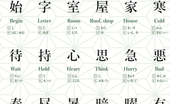
JLPT N4 Kanij List - All 176 Characters You Need To Know
After mastering the JLPT N5 kanji, you're ready to take your Japanese kanji game to the next level. JLPT N4. Let's go...
-

Kanji For Kanji - 漢字
Inception time. Which kanji compose the kanji of "kanji"? The kanji for "kanji" is actually pretty straightforward. I...
-

How to Memorize Katakana Easily: 9 Tips for Beginners
For those diving into Japanese, mastering hiragana and katakana is the first significant challenge. While hiragana o...
-
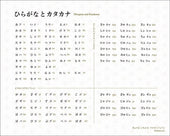
Complete Hiragana and Katakana Chart With All 112 Characters
The very first step for everybody who wants to learn Japanese is to study the hiragana and katakana chart (before lea...
-
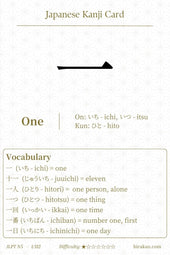
JLPT N5 Kanji: Kanji For One 一 (ichi)
Probably one the most simple kanji to remember, the kanji for 'one' is simply written '一'. Let's see its readings and...
-

How Long Does It Take to Learn Kanji? A Beginner's Guide
Ask any Japanese student what's the scariest part of learning the language, and they'll say kanji. And they're righ...
-
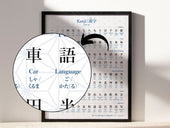
Is it Necessary to Learn Kanji? The Last Answer You'll Ever Need
Many beginners in Japanese wonder whether they should really learn kanji. I know this, because I also wondered when s...
-

How Long Does it Take to Learn Hiragana and Katakana?
As a beginner in Japanese, your first step is diving into the alphabets of Hiragana and Katakana. These are the build...
-

13 Best YouTube Channels to Learn Japanese, From Beginner to Intermediate
YouTube can be an incredible resource for learning Japanese. And best of all, it's free. So we've compiled a list of ...
-

Top 10 Manga for Japanese Language Learners: From Beginners to Intermediates!
If you're learning Japanese, chances are you're interested in manga. So instead of reading texts about Tanaka-san s...
-

Kanji for 'Fire' in Japanese: 火 or 炎?
Welcome to our enlightening exploration of Japanese kanji! Today, we're igniting our understanding of a primal force ...
-

The Complete Guide to Country Names in Japanese: Say and Pronounce Them Right!
Whether you're planning a trip, learning Japanese, or just curious about how different countries are represented in a...
-

Kanji for Peace: 平, 和, 泰 - The Symbols of Harmony
You might be wondering what are the Japanese symbols for 'Peace'. In this article, we're diving deep into this univer...
-

Kanji for 'Love': How and When to Use 愛 and 恋
Welcome to our journey into the world of Japanese kanji! Today, we're delving into one of the most heartwarming and p...
-

Kanji for 'Hot' in Japanese: 暑, 湯, and 熱 - A Comprehensive Guide
Welcome to our journey into the world of Japanese kanji! Today, we're going to delve into an exciting and essential c...
-
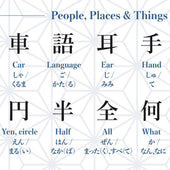
JLPT N5 Kanji List - All 112 Characters You Need To Know
Below we've listed all 112 JLPT N5 level kanji along with their English meaning, readings, and two accompanying vocab...

![この・その・あの・どの – Using ‘This / That / Which’ with Nouns in Japanese [JLPT N5]](http://hirakan.com/cdn/shop/articles/acd351ada3fe4b04ae86de788a3350b8.jpg?v=1766305268&width=170)
![これ・それ・あれ・どれ – Saying ‘This / That / Which One’ in Japanese [JLPT N5]](http://hirakan.com/cdn/shop/articles/this-that.jpg?v=1766305107&width=170)
![か~か – Expressing Choices like “A or B” in Japanese [JLPT N5]](http://hirakan.com/cdn/shop/articles/choices.jpg?v=1766304827&width=170)
![~から~まで – Saying “From A to B” in Japanese [JLPT N5]](http://hirakan.com/cdn/shop/articles/from-AtoB.jpg?v=1765093560&width=170)
![まで – Expressing “Until” and “Up To” in Japanese [JLPT N5]](http://hirakan.com/cdn/shop/articles/until-up-to.jpg?v=1765093405&width=170)
![から – Expressing “Because” and “From/Since” in Japanese [JLPT N5]](http://hirakan.com/cdn/shop/articles/because-from_since.jpg?v=1765093285&width=170)
![や – Listing Examples with “And, Among Others” in Japanese [JLPT N5]](http://hirakan.com/cdn/shop/articles/and.jpg?v=1765093138&width=170)
![か – Forming Questions and Saying “Or” in Japanese [JLPT N5]](http://hirakan.com/cdn/shop/articles/ka-questions.jpg?v=1763787134&width=170)
![も – Saying “Also” and “Too” in Japanese [JLPT N5]](http://hirakan.com/cdn/shop/articles/mo-also-too_99f908e6-78d0-4f82-8319-391ef42764bc.jpg?v=1763787251&width=170)
![と – Linking 'And', 'With', and Quotations in Japanese [JLPT N5]](http://hirakan.com/cdn/shop/articles/to-and-with-quotation.jpg?v=1763265110&width=170)
![で – Marking Where and How an Action Happens in Japanese [JLPT N5]](http://hirakan.com/cdn/shop/articles/de-where-how-action-happens.jpg?v=1763264973&width=170)
![へ – Marking Direction ‘Toward’ in Japanese [JLPT N5]](http://hirakan.com/cdn/shop/articles/he-marking-direction.jpg?v=1762667986&width=170)
![に – Marking Time, Destinations, and Recipients in Japanese [JLPT N5]](http://hirakan.com/cdn/shop/articles/ni-marking-destination.jpg?v=1762667846&width=170)
![の – Possession and Noun Linking in Japanese [JLPT N5]](http://hirakan.com/cdn/shop/articles/no-possession-and-noun-linking.jpg?v=1761961297&width=170)
![を – Marking the Direct Object in Japanese [JLPT N5]](http://hirakan.com/cdn/shop/articles/o-direct-object.jpg?v=1761960990&width=170)
![が – Marking the Subject ('Who/What') in Japanese [JLPT N5]](http://hirakan.com/cdn/shop/articles/ga-subject-marker_60f30f70-6ca5-47ee-9a00-3646195d7d3c.jpg?v=1761386355&width=170)
![は (wa) – Topic Marker and Contrast in Japanese [JLPT N5]](http://hirakan.com/cdn/shop/articles/wa-topic-marker.jpg?v=1761385996&width=170)
![じゃない・ではありません – Expressing 'Is/Was Not' in Japanese [JLPT N5]](http://hirakan.com/cdn/shop/articles/janai-dehaarimasen_2594963b-531e-4f4d-a9b0-361010e0a720.jpg?v=1760865884&width=170)
![だ・です/だった・でした – Saying ‘to be’ in Japanese [JLPT N5]](http://hirakan.com/cdn/shop/articles/da-desu-datta-deshita_58bbc732-53fd-48da-83c7-4e477e7cc0b2.jpg?v=1760864506&width=170)






















